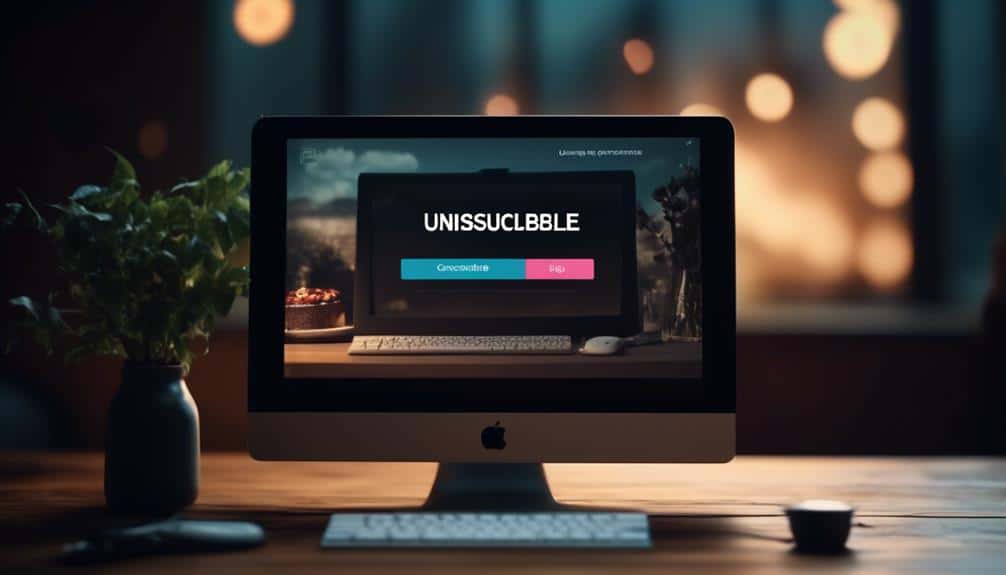Master the Art of Handling Unsubscribe Requests to Boost Your Email Reputation
Unsubscribe requests are like waves crashing against the shore of your email reputation. They can't be ignored, but they also don't have to be dreaded. In fact, mastering the art of handling these requests can actually boost your email reputation and help you build stronger relationships with your subscribers.
So, how exactly can you navigate these waves and come out on top? Stay tuned as we explore some key strategies and techniques that will not only make your unsubscribe process seamless and efficient but also leave a lasting positive impression on your subscribers.
Key Takeaways
- Unsubscribe requests are important for maintaining email reputation and user experience.
- Simplifying the unsubscribe process and providing user-friendly features can improve customer experience and reduce unsubscribes.
- Offering alternative email preferences, such as frequency and content options, can cater to individual needs and reduce unsubscribes.
- Personalizing the unsubscribe experience through customized options and alternative communication channels can enhance user satisfaction and improve future campaigns.
Importance of Unsubscribe Requests

Unsubscribe requests play a crucial role in maintaining email reputation and ensuring a positive user experience. When users decide to opt out of receiving further emails, it's essential to handle these requests promptly and effectively. By doing so, you not only reduce the risk of being marked as spam, but you also demonstrate respect for your subscribers' preferences.
Reducing attrition, or email churn, is a key objective for any business or organization that relies on email marketing. When users receive emails they no longer wish to receive, they may become frustrated and mark them as spam. This can harm your email reputation and lead to deliverability issues. By providing a clear and easy-to-use unsubscribe process, you give users the option to opt out of your emails without resorting to marking them as spam.
Moreover, handling unsubscribe requests professionally and promptly shows your commitment to serving your audience. It demonstrates that you value their preferences and respect their right to choose. By making the unsubscribe process simple and hassle-free, you enhance the overall user experience and build trust with your subscribers.
Optimize Your Unsubscribe Process
To optimize your unsubscribe process, consider implementing user-friendly features and clear instructions. This won't only improve the customer experience but also reduce the number of unsubscribes. Here are three key features to consider:
- Simplified Unsubscribe Button: Make it easy for your subscribers to find the unsubscribe button by placing it prominently in your email. A clear and visible button will save your customers time and frustration, ultimately improving their experience with your brand.
- One-Click Unsubscribe: Streamline the unsubscribe process by allowing users to unsubscribe with just one click. This eliminates the need for additional steps or forms, making it quick and hassle-free for your subscribers to opt out of receiving further emails.
- Preference Center: Offer your subscribers a preference center where they can customize their email preferences. This allows them to choose the types of emails they want to receive, reducing the likelihood of them unsubscribing altogether.
Provide Clear and Easy Unsubscribe Options

Make it effortless for your subscribers to opt out of receiving further emails by providing clear and user-friendly options. Ensuring that your unsubscribe process is easy to navigate and transparent not only respects your subscribers' preferences but also helps maintain a positive email reputation. By offering a hassle-free unsubscribe experience, you demonstrate your commitment to serving your audience's needs.
To provide clear unsubscribe options, include a prominent and visible unsubscribe link in your emails. This link should be easy to find, preferably placed at the top or bottom of your email content. Additionally, consider offering an alternative subscription option, such as a preference center, where subscribers can choose to receive only specific types of emails or reduce the frequency of communications.
To further improve your unsubscribe process, it's essential to gather unsubscribe feedback. Include a brief survey or a simple text box where subscribers can share their reasons for unsubscribing. This feedback can provide valuable insights into potential areas for improvement in your email marketing strategy. By actively listening to your subscribers' feedback, you can adapt and refine your email content to better meet their needs, potentially reducing unsubscribe rates in the future.
Offer Alternative Email Preferences
By offering alternative email preferences, you can cater to your subscribers' specific needs and reduce the likelihood of them wanting to unsubscribe. Effective email subscription management involves understanding that not all subscribers have the same preferences and providing them with options that suit their individual preferences.
Here are three alternative email preferences you can offer to keep your subscribers engaged:
- Frequency options: Allow subscribers to choose how often they receive emails from you. Some may prefer to receive daily updates, while others may only want to hear from you on a weekly or monthly basis. Giving them the flexibility to decide will make them feel more in control of their inbox and less likely to unsubscribe.
- Content preferences: Offer subscribers the ability to select the types of content they're most interested in. By tailoring your emails to their specific interests, you can provide them with valuable and relevant information that keeps them engaged and less likely to unsubscribe.
- Personalization options: Give subscribers the option to personalize their emails, such as addressing them by their first name or including personalized recommendations based on their past interactions. Personalization creates a sense of connection and makes subscribers feel valued, increasing their loyalty and decreasing the chances of them wanting to unsubscribe.
Personalize the Unsubscribe Experience

When it comes to personalizing the unsubscribe experience, there are two key points to consider.
First, offering customized unsubscribe options allows subscribers to tailor their preferences and stay connected with content that interests them.
Second, simplifying the opt-out process by making it easy and quick for users to unsubscribe can help improve their overall experience and prevent them from marking emails as spam.
Customized Unsubscribe Options
To enhance the unsubscribe experience, consider personalizing the options available to recipients. By customizing email templates and redesigning the unsubscribe button, you can create a more user-friendly and empathetic process.
Here are three ways to personalize the unsubscribe experience:
- Provide alternative communication channels: Offer recipients the option to receive updates through different channels, such as social media or SMS, instead of completely unsubscribing. This allows them to stay connected with your brand on platforms they prefer.
- Offer frequency options: Give recipients the ability to adjust the frequency of emails they receive. Providing options like weekly or monthly newsletters can help them feel in control of their inbox and reduce the urge to unsubscribe.
- Collect feedback: Include a feedback option in the unsubscribe process. This shows that you value their opinion and gives them an opportunity to provide valuable insights that can help improve future email campaigns.
Simplify Opt-Out Process
To simplify the opt-out process and personalize the unsubscribe experience, consider implementing user-friendly features and options. By doing so, you can make it easier for recipients to unsubscribe from your emails, which can lead to a reduction in your unsubscribe rate.
One suggested improvement is to provide a clear and prominent unsubscribe link or button in your emails. This allows recipients to easily locate and click on the option if they no longer wish to receive your emails.
Another option is to offer alternative frequency settings, allowing subscribers to choose how often they receive emails from you. This personalization can help retain subscribers who may not want to completely unsubscribe but simply receive emails less frequently.
Implement a Confirmation or Feedback Page
Consider implementing a confirmation or feedback page to enhance the user experience and gather valuable insights from unsubscribe requests. By providing a confirmation page, you can assure users that their request has been successfully processed, reducing any potential frustration or confusion. Additionally, a feedback page allows users to provide reasons for unsubscribing, which can offer valuable information to improve your email campaigns and content.
Here are three reasons why you should implement a confirmation or feedback page:
- Improved user experience: A confirmation page provides users with a sense of closure and reassurance that their unsubscribe request has been acknowledged. This can enhance their overall experience with your brand and prevent any negative sentiment.
- Insights for improvement: The feedback page allows users to share their reasons for unsubscribing, giving you valuable insights into what aspects of your emails may be falling short. This feedback can guide you in making necessary improvements and tailoring your content to better meet the needs and preferences of your audience.
- Opportunity for re-engagement: By including a feedback page, you create an opportunity to re-engage with users who may have unsubscribed due to specific issues. You can provide them with options to update their preferences, receive less frequent emails, or explore other content offerings, potentially retaining them as valuable subscribers.
Implementing a confirmation or feedback page not only enhances the user experience but also provides you with valuable information to optimize your email campaigns and maintain a positive email reputation.
Monitor and Analyze Unsubscribe Data
To effectively monitor and analyze unsubscribe data, you need to focus on three key points.
First, analyze your unsubscribe rate to identify any trends or patterns that can help you improve your email campaigns.
Second, track the reasons why subscribers are opting out to gain insights into any potential issues or areas for improvement.
Finally, implement email preference management to allow subscribers to choose the frequency and type of content they receive, reducing the likelihood of unsubscribing altogether.
Unsubscribe Rate Analysis
Analyzing unsubscribe data allows you to gain insights into your email campaign's effectiveness and make informed decisions to improve your email reputation. By benchmarking your unsubscribe rate against industry standards, you can determine how well you're doing compared to others. This can help you identify areas for improvement and set realistic goals for reducing your unsubscribe rate.
Additionally, analyzing unsubscribe data can help you understand the reasons behind unsubscribes, such as irrelevant content or too frequent emails. Armed with this information, you can implement strategies to address these issues, such as segmenting your audience and personalizing your emails.
This won't only reduce your unsubscribe rate but also improve the overall engagement and satisfaction of your subscribers.
Opt-Out Reasons Tracking
Tracking and analyzing opt-out reasons is essential for understanding why subscribers are unsubscribing from your emails and can provide valuable insights for improving your email campaign. By monitoring and analyzing the reasons behind opt-outs, you can gain a deeper understanding of your subscribers' preferences, needs, and concerns. This information allows you to make informed decisions about your email content, design, and frequency, ultimately leading to better engagement and a lower unsubscribe rate.
To conduct an effective opt-out reasons analysis, start by categorizing the reasons provided by unsubscribing subscribers. Common categories may include email frequency, irrelevant content, poor design, and lack of personalization. Analyze the data to identify patterns and trends, and then use this information to optimize your email campaigns.
Email Preference Management
Wondering how to effectively monitor and analyze unsubscribe data for better email preference management?
Monitoring and analyzing unsubscribe data can greatly improve your email deliverability and enhance your email list management. Here are three crucial reasons why you should pay attention to this data:
- Gain insights into customer preferences: Unsubscribe data can provide valuable information about why recipients are opting out, helping you understand their preferences and tailor your email content accordingly.
- Identify problem areas: By monitoring unsubscribe data, you can identify patterns or trends that indicate potential issues with your email campaigns, allowing you to make necessary improvements.
- Improve email deliverability: Analyzing unsubscribe data can help you identify and address potential deliverability issues, such as high complaint rates or spam complaints, ensuring that your emails reach the intended recipients.
Continuously Improve Your Unsubscribe Process

To continuously improve your unsubscribe process, consider implementing user-friendly features and proactive measures. By doing so, you can enhance customer satisfaction and reduce email fatigue.
Start by making it easy for subscribers to unsubscribe. Include a prominent unsubscribe link in your emails and ensure it's visible and accessible. Avoid hiding the unsubscribe option or making it difficult to find, as this can frustrate recipients and negatively impact their perception of your brand.
Another way to improve your unsubscribe process is by offering alternative options. Provide subscribers with the option to manage their email preferences instead of completely unsubscribing. This allows them to select the types of emails they want to receive and helps to reduce the likelihood of them unsubscribing altogether.
Additionally, consider implementing a feedback mechanism. When someone unsubscribes, provide them with a brief survey or feedback form to gather insights into their reasons for unsubscribing. This information can be invaluable in identifying areas for improvement and addressing any issues that may be contributing to unsubscribes.
Lastly, regularly review and analyze your unsubscribe data. Look for patterns or trends to identify potential areas where you can make adjustments to improve your email content, frequency, or targeting.
Frequently Asked Questions
How Can I Prevent Subscribers From Unsubscribing From My Emails?
To prevent subscribers from unsubscribing from your emails, focus on subscriber retention strategies and effective email segmentation. Provide valuable content that meets their needs and interests, making them less likely to want to unsubscribe.
What Are Some Best Practices for Designing an Unsubscribe Confirmation Page?
To design a great unsubscribe confirmation page, focus on conversion optimization and user experience. Make it easy for users to unsubscribe, offer alternatives, and gather feedback. Keep it concise, informative, and professional to serve your audience effectively.
Is It Possible to Track the Reasons Why Subscribers Are Unsubscribing From My Emails?
Yes, it is possible to track the reasons why subscribers are unsubscribing from your emails. Tracking unsubscribes has benefits and limitations, but implementing personalized content can help reduce unsubscribes by catering to individual preferences and interests.
How Often Should I Analyze and Evaluate the Data From Unsubscribes?
You should analyze and evaluate the data from unsubscribes regularly to reduce your unsubscribe rates. By doing this, you can identify trends, make necessary improvements, and ultimately boost your email reputation.
Are There Any Legal Requirements or Regulations Regarding the Unsubscribe Process for Email Marketing?
To ensure compliance with email marketing regulations, there are legal requirements for the unsubscribe process. Providing a clear and easy way for recipients to opt out of future emails is essential for maintaining a positive reputation.
Conclusion
Mastering the art of handling unsubscribe requests is crucial for boosting your email reputation.
By optimizing your unsubscribe process, providing clear and easy options, offering alternative email preferences, personalizing the experience, implementing a confirmation or feedback page, and monitoring and analyzing unsubscribe data, you can continuously improve your unsubscribe process and maintain a positive email reputation.
Remember, taking proactive steps to respect your subscribers' preferences will ultimately enhance your email marketing efforts.








